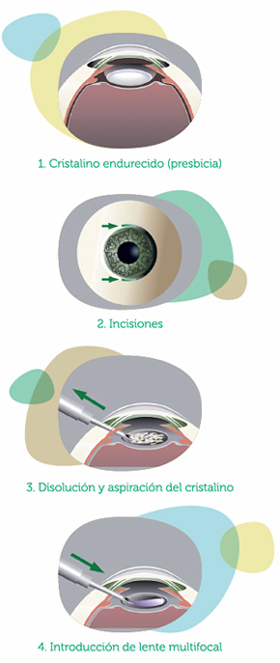What causes presbyopia?
The crystalline is a flexible lens inside the eye, behind the pupil. Its elasticity allows it to change shape to focus on objects at different distances. With time the lens hardens and so loses elasticity, with the result thatthe focus point gradually gets further away. It must be pointed out that this is a physiological process and affects all patients at the ages mentioned and is just the first step in the transparent crystalline becoming opaque with cataracts later in life. It is therefore important to bear in mind that there are no exercises or drugs that can prevent the onset of presbyopia.
What are the symptoms of presbyopia?
Symptoms typically consist of difficulty in seeing small objects close up, the need to hold these objects away from us to be able to focus on them better, or to find better light. In general, the symptoms start earlier in patients who are far-sighted, then in those who are emmetropic, i.e. those who do not need glasses for distance, and finally in those who are myopic, or near-sighted.
Can presbyopia be operated on?
Until recently refractive surgery (a procedure aiming to eliminate or reduce the need for glasses) produced excellent results in the correction of short-sightedness, far-sightedness and astigmatism, particularly in the last 15 years with the use of the Excimer laser and derived techniques, although it did not correct presbyopia satisfactorily. The procedure gave ‘incomplete’ or temporary solutions for many patients of 45-50 years of age wanting to leave their glasses behind. Spectacular advances in the design of intraocular lenses have led to the development of the multifocal intraocular lens, so we can now say that yes, there is a solution for presbyopia, with highly satisfactory results for the patient.
How does the surgical correction of presbyopia work?
 Presbyopia, as we have explained, is caused by the loss of elasticity in the crystalline. Therefore, it seems to make sense to seek the solution in replacing the hardened crystalline with a multifocal intraocular lens, with which not only presbyopia is corrected, but also certain degrees of near-sightedness or far-sightedness the patient may have had previously. So the patient’s sight is satisfactory without glasses for longer distances and good enough for shorter distances for everyday life (to read the newspaper, to read the prices on articles when shopping, etc.), reducing the need for glasses with very small items or in bad light.
Presbyopia, as we have explained, is caused by the loss of elasticity in the crystalline. Therefore, it seems to make sense to seek the solution in replacing the hardened crystalline with a multifocal intraocular lens, with which not only presbyopia is corrected, but also certain degrees of near-sightedness or far-sightedness the patient may have had previously. So the patient’s sight is satisfactory without glasses for longer distances and good enough for shorter distances for everyday life (to read the newspaper, to read the prices on articles when shopping, etc.), reducing the need for glasses with very small items or in bad light.